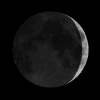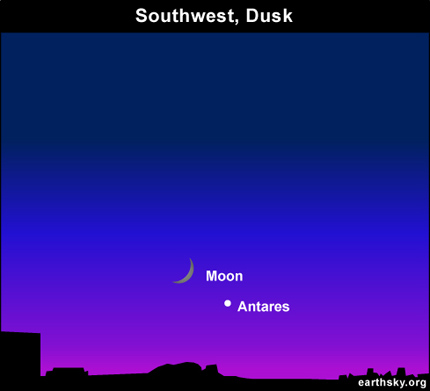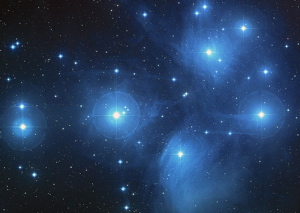Courtesy of EarthSky
A Clear Voice for Science
www.EarthSky.org

 See Comet Hartley 2 from early to mid October 2010
See Comet Hartley 2 from early to mid October 2010
The bright star near the moon on October 11 is Antares, Heart of the Scorpion in the constellation Scorpius. It is a red star, but you might not see its reddish color against the fading colors of twilight. Our chart shows the moon and Antares shortly after sunset, when they are low in the southwest. They will set not far behind the sun.
North American viewers will see Antares to the west (right) of the waxing crescent moon this evening. In Asia, Antares is found to the east (left) of the moon. In Europe, Antares appears pretty much under the moon.
Bright star in the east on October evenings? It is the planet Jupiter
At mid-northern latitudes all around the world, Antares sets in early evening at this time of year. Farther north, Antares sets even earlier, whereas farther south Antares sets at a later hour. In fact, at middle latitudes south of the equator – like at southern Australia and New Zealand – Antares sets a good 3 hours later than at our mid-northern latitudes.
 As the moon and the star Antares set in your southwestern sky this evening, turn in the opposite direction, and look for the Pleaides star cluster – also known as the Seven Sisters. The Pleaides will rise in your northeastern sky.
As the moon and the star Antares set in your southwestern sky this evening, turn in the opposite direction, and look for the Pleaides star cluster – also known as the Seven Sisters. The Pleaides will rise in your northeastern sky.
With the eye alone, you can easily spot the Pleaides in the northeast in early evening. It looks like a tiny misty dipper of stars. The image at right shows the Pleiades star cluster as seen through a telescope.
One thing remains constant, no matter where you live worldwide. Whenever Antares sets in your southwest sky, the Pleiades star cluster in the constellation Taurus the Bull rises into your northeast sky. Another thing remains constant as well. Antares sets 4 minutes earlier every day while the Pleiades star cluster rises 4 minutes earlier daily.
By mid to late November, Antares will disappear from the night sky, while the Pleiades star cluster will shine all night long! After the moon and Antares follow the sun beneath the horizon this evening, the Pleaides star cluster will be out for rest of the night.
Written by Bruce McClure
Astronomy Picture of the Day from NASA/JPL
U.S. Naval Observator Astronomical Information center
The York County Astronomical Society